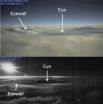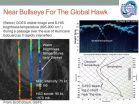NASA's HS3 mission returned to NASA's Wallops Flight Facility, in Wallops Island Virginia for the third year to investigate the processes that underlie hurricane formation and intensity change in the Atlantic Ocean basin.
NASA's Global Hawk aircraft are unmanned and autonomously operated. That means that pilots located in a control room on the ground continuously monitor the flights. The flight plans are pre-programmed into the Global Hawk's flight control computer from takeoff to landing. However, with guidance from HS3's mission scientists, the pilots often make changes or adjustments to the flight pattern to target particular areas of the storms.
Two of the instruments aboard the Global Hawk that gathered data are the S-HIS and CPL. The S-HIS or Scanning High-resolution Interferometer Sounder gathered a continuous sampling of temperature and relative humidity in the clear-air environment, while the CPL or Cloud Physics Lidar analyzed the vertical structure of aerosols (tiny particles) and the vertical structure of the cloud layers of the hurricane. In addition to the S-HIS and CPL, the Advanced Vertical Atmospheric Profiling System (AVAPS) launched into the hurricane dropsondes that measured profiles of temperature, humidity and full tropospheric wind (winds in every level of the troposphere from top to bottom as the sonde falls).
The Fifth Science Mission Provides a Look at Newly Formed Tropical Storm Edouard's Layers
During the Sept. 11-12 flights over Tropical Storm Edouard, "At 800 millibars (about 2 km or 1.2 miles above the surface) the wind field showed a well-organized cyclonic circulation with winds of at least 35 knots (40.2 mph/64.8 kph) on the eastern side of the storm," said Dr. Scott Braun, HS3 Mission Principal Investigator from NASA's Goddard Space Flight Center in Greenbelt, Maryland.
"The air was generally moist at most dropsonde points except for a few places at large distance from the center and right near the center. The point near the center showed evidence of substantial subsidence (sinking motions) and warming, a relatively weaker wind speed, and a surface pressure of 999 millibars, reminiscent of potentially indicating conditions in a forming eye."
Data from higher levels in the atmosphere, at 400 millibars, also proved interesting. The data showed that Edouard's center of circulation was located northeastward of the lower center at 800 millibars. That means that there was westerly to southwesterly vertical wind shear pushing the higher-level of circulation away from the lower level one. "Secondly," Braun said, "very dry air was being swept into the southern portion of the storm by moderate-strength westerly winds. The combination of shear and dry air aloft likely kept Edouard a weak tropical storm."
The Global Hawk concluded its fifth science flight on Sept. 12 at 5:50 p.m. EDT when it landed on the runway at Wallops.
The Sixth Science Mission Shoots a Bullseye!
On Sunday morning, September 14, 2014 at 1102 UTC (7:02 a.m. EDT) NASA's Global Hawk 872 took off from NASA Wallops on a second flight toward Tropical Storm Edouard for a 24 hour mission. It was the sixth science flight for the Global Hawk during the HS3 mission.
When the Global Hawk departed from Wallops, Edouard was a tropical storm. At 5 a.m. EDT Edouard had 70 mph sustained winds, and it only needed to reach 74 mph to be declared a Category One hurricane. The National Hurricane Center expected Edouard to become a hurricane soon after the flight departed.
Scott Braun, HS3 Principal Investigator, and Paul Newman, HS3 deputy principal investigator, both of NASA's Goddard Space Flight Center in Greenbelt, Maryland were monitoring the flight. At 8 a.m. EDT they noted that Edouard's winds remained at 70 mph and the minimum central pressure was at 992 millibars, but had recently formed an eye.
They observed that Edouard was interacting with southerly wind shear, but anticipated that the shear would weaken over time, which would allow Edouard to strengthen. Data showed that Edouard had dry air wrapping around the circulation, but it was unclear if it was inhibiting development.
By 8:35 p.m. EDT on Sunday, Sept. 14, "Science Flight #6 was proceeding into the previously named Tropical Storm Edouard now called Hurricane Edouard, which is Category one in wind speed," said Ronald Walsh, Senior Project Manager at NASA Wallops.
Michael L. Black, one of HS3's mission scientists and a Research Meteorologist in NOAA's Hurricane Research Division, Miami, Florida said "I've been working the overnight shift and evidently, Edouard has been undergoing a period of fairly substantial rapid intensification. We have had several drops near the eye/eyewall border that have reported a sea-level pressure of 969-970 millibars. These sondes had near-surface winds approaching 90 knots (103.6 mph/166.7 kph), so obviously the central pressure in the eye would be lower, perhaps as low as 960 millibars." In all, the Global Hawk dropped 80 sondes over the storm at high frequency and many were very near the eye of the storm.
Global Hawk 872 landed around 7 a.m. EDT on Monday, September 15, 2014 concluding its sixth science flight.
The Global Hawk returned to Hurricane Edouard twice more. Flight seven occurred on Sept. 16-17 after Edouard briefly attained major hurricane intensity (Category 3, the first such intense storm that the Global Hawk overflew as part of HS3). Flight eight was on Sept. 18-19 when Edouard rapidly weakened from a hurricane to a weak tropical storm.
INFORMATION:
The HS3 mission is funded by NASA Headquarters and overseen by NASA's Earth System Science Pathfinder Program at NASA's Langley Research Center in Hampton, Virginia. It is one of five large airborne campaigns operating under the Earth Venture program.
The HS3 mission also involves collaborations with partners including the National Centers for Environmental Prediction, Naval Postgraduate School, Naval Research Laboratory, NOAA's Unmanned Aircraft System Program, Hurricane Research Division and Earth System Research Laboratory, Northrop Grumman Space Technology, National Center for Atmospheric Research, State University of New York at Albany, University of Maryland - Baltimore County, University of Wisconsin, and University of Utah. The HS3 mission is managed by the Earth Science Project Office at NASA Ames Research Center, Moffett Field, California. The aircraft are maintained and based at NASA's Armstrong Flight Research Center in Edwards, California.



